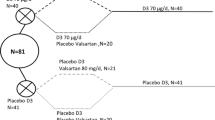Summary
To test the hypothesis that muscle weakness associated with aging is in part due to low serum levels of vitamin D, we investigated the relationship between muscle strength and serum levels of vitamin D metabolites in ambulatory elderly people who were not receiving vitamin D supplementation.¶ We enrolled 319 ambulatory elderly subjects (103 women: mean age 74.2, age range 65–86; 216 men: mean age 76.6, age range 66–95) between April and August 1995. The study design was cross-sectional. Muscle strength was measured as leg extension power in watts (LEP). Mean 25-hydroxyvitamin D serum concentrations were higher in male participants at 36.2ng/ml (range 3.0–85.0) versus 27.4ng/ml (range 5.0–88.0) in female subjects (p=0.008). We found 12 percent of female and 18 percent of male subjects with 25-hydroxyvitamin D values below the lower threshold (<12ng/ml). Mean 1,25-dihydroxyvitamin D levels were similar in both sexes: 39.8pg/ml (range 15.0–73.0) in women and 37.9pg/ml (range 13.0–69.0) in men. LEP declined with age in women and men (f: r=–0.35, p=0.001; m: r=–0.48, p<0.0001). Men were significantly stronger than women (p<0.0001). In men both 25-hydroxyvitamin D and 1,25-dihydroxyvitamin D showed pairwise correlation with LEP (r=0.24; p=0.0004/r=0.14; p=0.045). In women only 1,25-hydroxyvitamin D was significantly correlated with LEP (r=0.22; p=0.03). In ANCOVA, including all participants, explaining LEP by sex (p<0.0001), age (p<0.0001), BMI (p=0.013), 1,25-dihydroxyvitamin D (p=0.02), 25-hydroxyvitamin D (p=0.18) and iPTH (p=0.82), all factors showed significant effects except 25-hydoxyvitamin D and iPTH (r2 of the whole model: 0.41).¶ In conclusion our results support the view that, in concert with other factors, deficiency of both 25-hydroxyvitamin D and 1,25-hydroxyvitamin D contributes to the age-related decline in muscle strength. Modest, but significant relationships between 1,25-dihydroxyvitamin D and muscle strength in both sexes, and 25-hydroxyvitamin D in male participants could be documented. Whether the impact of vitamin D on calcium homeostasis and bone mineral density or directly on the muscle tissue level is more important for prevention of hip fractures remains unclear. Further prospective and comparative treatment studies should be performed, in order to evaluate whether and in which dose requirements, vitamin D supplementation can improve muscle strength in the elderly.
Similar content being viewed by others
Author information
Authors and Affiliations
Rights and permissions
About this article
Cite this article
Bischoff, H., Stähelin, H., Tyndall, A. et al. Relationship between muscle strength and vitamin D metabolites: are there therapeutic possibilities in the elderly?. Z Rheumatol 59 (Suppl 1), I39–I41 (2000). https://doi.org/10.1007/s003930070037
Published:
Issue Date:
DOI: https://doi.org/10.1007/s003930070037




